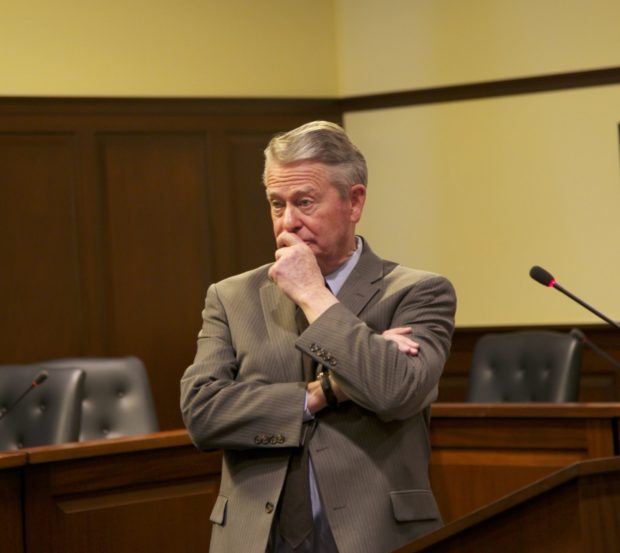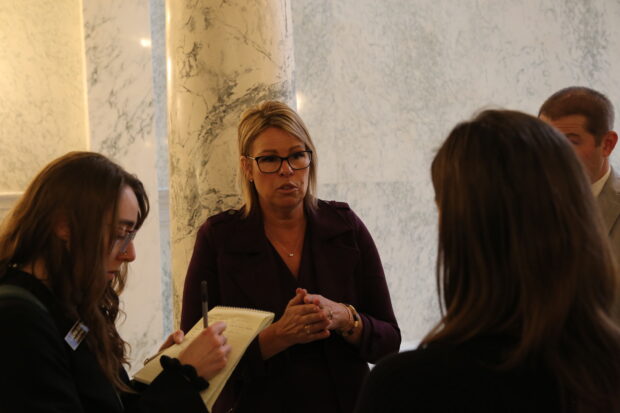Here’s one place where Idaho is making up ground — and moving faster than most other states.
But you probably won’t hear much talk about it.
In 2021, about 51% of the state’s young adults had finished some form of postsecondary education: college, a career-technical education program or workforce training.
That’s still below the national average of 56%. But Idaho’s completion rate has improved by more than 7 percentage points since 2019. According to the Lumina Foundation — the Indianapolis-based nonprofit that has been compiling completion rates for more than a decade — Idaho is posting some of the biggest improvements in the nation.
Sounds like good news. But does anyone care?
The surge comes after Idaho’s leaders have all but abandoned their once-ballyhooed “60% goal” for completion, saying it isn’t a fair or useful education metric. In fact, the 60% goal doesn’t even appear in a State Board of Education strategic plan, up for a vote next week.
But even if state leaders are ambivalent about this goal, the latest numbers tell us a lot about Idaho’s education demographics.
The ‘60% goal,’ and Idaho’s sketchy track record
First, the short history. In 2010, Idaho’s education, political and business leaders coalesced behind the 60% target, focusing on the state’s 25- to 34-year-olds.
The state started at a grim 37% — although, in time, the state and Lumina also began counting CTE and workforce training towards the goal, in addition to two- and four-year college degrees.
Nonetheless, Idaho’s progress remained slow. The state was stuck at 42% for several years, finally improving in 2019 to 44%.
Considering the state’s original goal — reaching the 60% threshold by 2025 — several years of slow movement all but put that deadline beyond reach. Which probably helps explain why state leaders began souring on the goal in general. As Lewis-Clark State College President Cynthia Pemberton said in a 2021 State Board meeting, “It’s often used as a P.R. punishment for what we are not able to accomplish.”
Nonetheless, it’s important to put Idaho’s considerable recent improvements into perspective.
It took nine years, from 2010 to 2019, for the state to improve its postsecondary completion rate by 7 percentage points.
Idaho matched that improvement from 2019 to 2021.
How did this happen?
The big drivers were CTE and workforce training.
All told, 10% of Idaho’s young adults hold a professional certificate, generally offered by a community college, or a certification offered by an employer. That’s up from about 6% in 2019.
(Across the board, Idaho’s college completion rates also improved, or at least held steady.)
And there could be several factors behind Idaho’s surge in certificates and certifications.
Workplace demand is one factor: More employers are looking for trained workers.
Growth could be a factor — if trained workers are moving to Idaho looking to fill vacant jobs.
And it might be a sign that Idaho’s schools and employers emphasized in-person training during the COVID-19 pandemic. Similar programs went dark in other states, and certificate and certification rates decreased.
“Those (training) opportunities just didn’t exist for many of these certificates and certifications,” said Courtney Brown, director of Lumina’s Stronger Nation project, which tracks post-high school completion rates nationally.
Demographic trends: some improvements
Looking at “attainment,” at least an associate’s degree from a two-year college, the state saw two-year improvements across most demographic groups.
The rates were mixed for two sizeable — and chronically at-risk — demographic groups.
The attainment rate for Hispanic young adults improved from 19.4% to 23.8% over two years, reaching its highest point in more than a decade. (Lumina’s demographic numbers count only college graduation rates, not CTE and workforce training.)
For American Indian and Alaskan natives, the two-year numbers dipped slightly. The rate dropped from 21.6%, a 10-year peak, to 21.3%.
Not surprisingly, both of these numbers remain well below the overall state attainment rate of nearly 41%.
But the demographic improvements, especially among Idaho Hispanics, represent some “really good news,” Brown said. The improvements haven’t come in a vacuum. For years, the Idaho Commission on Hispanic Affairs and the state’s colleges and universities have made a concerted effort to boost these numbers — with scholarships and student supports designed to boost enrollment and grad rates.
In-state trends: a mixed bag
At the county-by-county level, attainment rates vary widely.
Not surprisingly, Idaho’s top five includes counties that have a college within their borders: Ada, Latah and Madison.
But the most educated county in the state, according to the Lumina numbers, sits in tourism and farm country on the Wyoming border. In Teton County, more than 57% of adults hold some kind of a degree — not quite to 60%, but closer than any other corner of the state. (Again, as with the demographic breakdowns, the county statistics represent college graduation rates, not CTE and workforce training.)
Jefferson County, situated between Brigham Young University-Idaho and the fledgling College of Eastern Idaho, rounds out the top five.
Also not surprisingly, relatively remote rural counties struggle with low attainment rates. In Owyhee County, only 19% of adults hold a degree. Boundary, Franklin, Gooding and Power counties round out the bottom five.
The county-by-county numbers underscore a hard reality, one that doesn’t appear to be changing. Colleges and universities continue to have a hard time recruiting rural students. The shortage of rural jobs requiring a college degree — a shortage reflected in Lumina’s county-by-county reports — contributes to the recruiting challenge. Simply put, it’s more difficult for recruiters to sell rural students and parents on the value of a degree.
How Idaho stacks up nationally
In the big picture, Idaho’s rankings remain mediocre.
Using the state’s old yardstick of choice — any form of postsecondary completion, among 25- to 34-year-olds — Idaho’s bottom line number is slightly more 51%.
The national average is close to 56%.
Idaho ranks No. 37 in the nation. Idaho lags behind all of its neighbors, except Nevada.
Yet in spite all of this, Idaho got a shoutout from Lumina last week, when it released its latest numbers.
This has less to do with the overall standings, and everything to do with the two-year trend. During a two-year period of coast-to-coast gains, Idaho’s overall completion rate improvements ranked third in the nation, trailing only Vermont and Indiana.
There is nothing obvious that connects these three states — geography, economics or politics. Lacking a common thread, Brown says the success stories really come down to the basics: targeting training with workforce needs.
But what does this metric actually measure?

In 2016 — back when Idaho was fully in 60% goal mode — then-Lt. Gov. Brad Little talked up the target. “I didn’t say this is a mild, timid, weak and modest goal,” Little told the House Education Committee, as he pushed a nonbinding resolution promoting the initiative. “This is a big hairy audacious goal.”
Asked about the latest numbers, Little sounded somewhat shy of audacious. “It is great to see Idaho land a top spot on yet another ranking,” said spokeswoman Madison Hardy, who used the Lumina news to tout Idaho Launch, Little’s controversial plan to provide high school graduates with up to $8,500 to pursue college, CTE programs or workforce training.
State superintendent Debbie Critchfield — who served on the State Board while Idaho began to distance itself from the 60% goal — was encouraged by the new numbers. To a point, anyway.
“I think Idaho’s definitions for success have evolved in the 13 years since Idaho first set its own 60% goal,” she said Tuesday. “Since then, I think we’ve realized that tracking postsecondary rates is an important measuring stick, but it’s one of many that we can use to measure our progress.”
But now it’s no longer a measuring stick in the State Board’s toolbox.
Last year, the board yanked the 60% goal from its list of performance benchmarks. Barring an abrupt and unlikely reversal next week, the State Board will omit the goal from its long-range strategic plan.
How come?

This week, executive director Matt Freeman restated the State Board’s concerns. The old 60% goal is a “weak performance measure,” he said, because it really measures who moves into Idaho, who stays, and who leaves. The board now is focused on Idaho’s lagging “go-on rate,” which directly measures the percentage of high school graduates who enroll in college.
In an interview last week, Brown bristled at the state’s criticism, and said there is a direct link between a state’s education policies and its completion rates.
If 18-year-olds don’t go to college — if Idaho’s go-on rates continue their pandemic-era malaise — that will translate into mediocre completion numbers when those 18-year-olds turn 25. State policies that encourage enrollment, and help students graduate, will also make a difference.
“I would say it’s absolutely up to policymakers to pay attention to enrollment,” she said. “(And) it’s not enough to enroll people and have them drop out.”
Each week, Kevin Richert writes an analysis on education policy and education politics. Look for it every Thursday.
